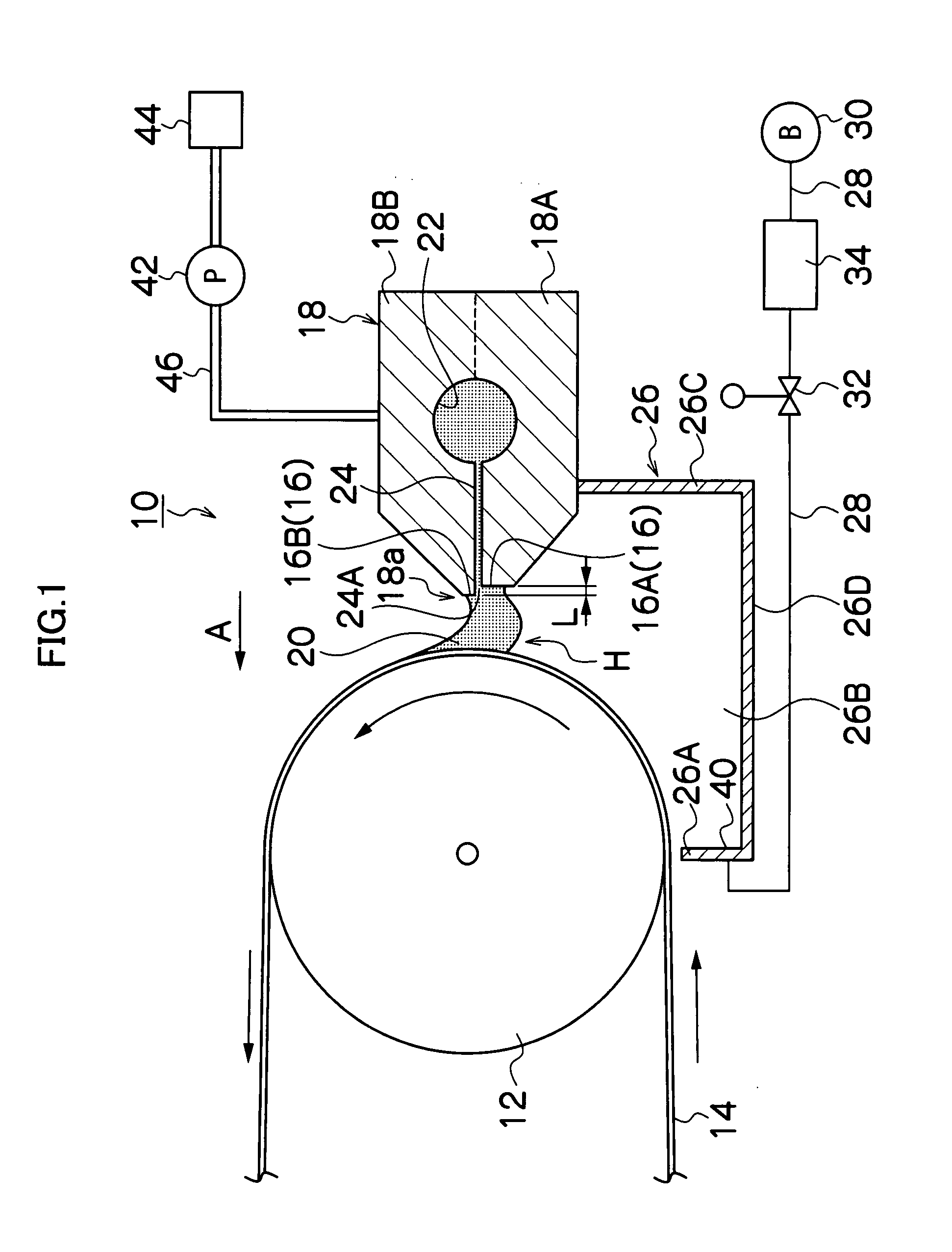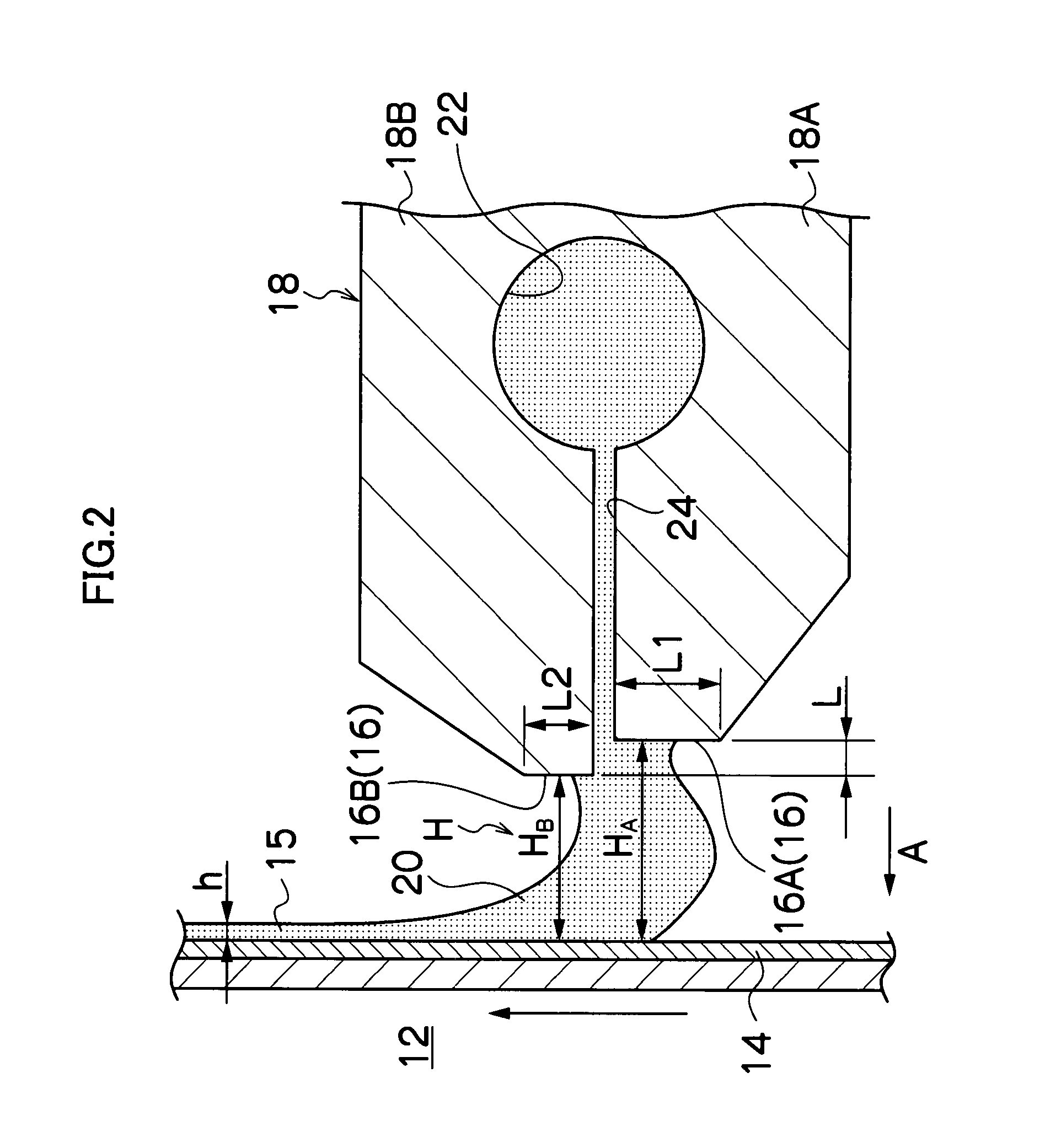Method and apparatus for applying coating solution
- Summary
- Abstract
- Description
- Claims
- Application Information
AI Technical Summary
Benefits of technology
Problems solved by technology
Method used
Image
Examples
example 1
[0105]In Tests 1 to 23 of Example 1, the coating method of the present invention was performed using the coating apparatus of the present invention by changing various factors as mentioned below. The form and state of the bead at the coating initiation process, at which the coating solution shown below was applied onto a web, and the state of the coating film formed on the web were observed and evaluated. Evaluation results were shown by evaluation scores: E (excellent), G (good), NG (no good), and P (poor).
[0106]Evaluation score E denotes that a bead of a coating solution was formed in the clearance from the coating initiation process; no irregular coating such as coating streak was observed on the coating surface; and the dimensional accuracy of the resultant film with respect to thickness is less than ±0.5% relative to a reference desired film-thickness.
[0107]Evaluation score G denotes that a bead of a coating solution was formed in the clearance from the coating initiation proce...
example 2
[0121]In Example 2, Test 24 to 36, 41, 42 and 44 were performed by changing the conditions: the wet-state thickness h of a film formed of a coating solution applied onto a web, coating speed (moving speed of a web), the viscosity of the coating solution, and surface tension of the coating solution, while satisfying preferable ranges of the factors (A), (B), (C) and (D) of Example 1.
[0122]For comparison, Tests 37 to 40 and 43 were performed which were all outside the preferable range with respect to factor (A), that is, the ratio H2 / H1 was 1.0.
[0123]The test results are shown in FIG. 7. In Tests 24 to 27, the viscosity of a coating solution is changed. In Tests 28 to 30, the surface tension of a coating solution is changed. In Tests 31 to 34 and 37 to 44, the wet-state thickness h of a coating film is changed. In Tests 35 and 36, a coating speed is changed.
[0124]As is apparent from FIG. 7, in Tests 24 to 36, 41, 42, 44, as long as preferable ranges of factors (A), (B), (C) and (D) of...
example 3
[0125]In Example 3, the coating conditions of Table 1 were changed to those shown in Table 2.
TABLE 2Coating speed60m / minWet-state film thickness h of coating film7.0μmCoating width1200mmDownstream-side clearance70μmOverbite amount70μmDownstream lipland length60μmSlot width140μmMaterial for width-regulating boardSUS630Degree of vacuum of vacuum chamber950PaMaterial for webTriacetylcellulose (TAC)
[0126]Of the factors (A), (B), (C) and (D) of Example 1, only factor (A) was changed in this Example. A ratio of H2 / H1 is 0.86 in Test 45, 1.0 in Test 46 and 1.1 in Test 47.
[0127]The test results are shown in FIG. 8. As is apparent from FIG. 8, in Test 45 where a first moving step where coating is started by moving a slot die to the coating initiation position (a) (the clearance H2 at the coating initiation process is lower than the clearance H1 at the standard coating process) and a second moving step where the slot die is moved to the standard coating position (b) having the clearance H1 in...
PUM
 Login to View More
Login to View More Abstract
Description
Claims
Application Information
 Login to View More
Login to View More - R&D
- Intellectual Property
- Life Sciences
- Materials
- Tech Scout
- Unparalleled Data Quality
- Higher Quality Content
- 60% Fewer Hallucinations
Browse by: Latest US Patents, China's latest patents, Technical Efficacy Thesaurus, Application Domain, Technology Topic, Popular Technical Reports.
© 2025 PatSnap. All rights reserved.Legal|Privacy policy|Modern Slavery Act Transparency Statement|Sitemap|About US| Contact US: help@patsnap.com



